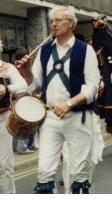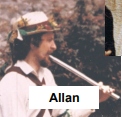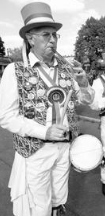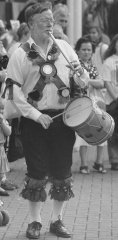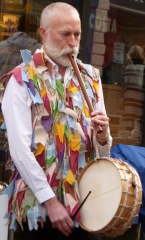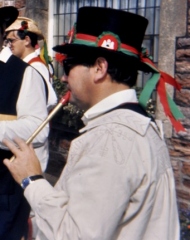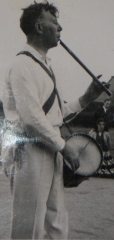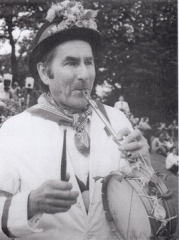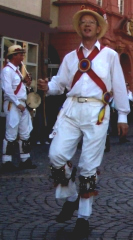| The pipe and tabor were played for Cotswold morris dancing in England for many centuries.
By the end of Victorian times it was superceded
by the violin and then the melodeon and accordian. In the late 20th century and 21st century there has been a revival of the pipe and tabor
playing for morris.
[This is not an exhaustive study of the morris, just some items I have come across - project manager ] |
"John the piper " occurs in some Newton charters about 1346.
" Myself above Tom Piper to advance,
Who so bestirs him in the Morris-dance,
For penny wage."
Drayton (" Eclogue" iii.) quoted in Rush Bearing by Alfred Burton 1891 p130 |
In the records of a 1448 feast, Careawey, a harpist, and a certain John Pyper are named, alongside morris dancers and other minstrels. Goldsmiths’ Wardens’ Accounts and Court Minutes, CL, 165 The theft of instruments, including morris bells (recorded in 1515). Court of Common Council, Journal 11, CL, 324, Court of Common Council, Journal 12, CL, 421 |
Morris dances that are mentioned with some regularity in the Reading Watch records between 1477 and 1541. The Drapers’ Wardens’ account for 1477, when the mayor was a draper, record that his company provided a morris dance and a pageant for the watch. In 1541 the Drapers provided a morris dance with its minstrel, a tabor, drums, and flutes. In 1512 the total cost for three pageants, including the morris dance, was £12 17s. 9d. In the 1520’s the Drapers provided a morris dance with its minstrel, a tabor, drums, and flutes, as well as pageants.
The Drapers’ Minutes and Records list:
Burnet, William; [minstrel; Morris dancer] 1522
Darrall [Darrell], William; [Morris dancer (leatherseller)] 1530
Fount [Fons, Founs], Walter; [Morris dancer; minstrel] 1525-36
Greves, Robert; [Morris dancer, minstrel] 1521
Lymmyr, John; [Morris dancer; minstrel (bowstring maker)] 1541
MUSICIANS AND COMMONERS IN LATE MEDIEVAL LONDON Simon Polson, Doctor of Philosophy, 2020 |
|
Morris dancing played an important role in the life of the church. Individual churches paid for food and drink and the costumes of the dancers as well as giving them a payment. It fell from favour after the Elizabethan Settlement of 1560. Thereafter, tainted by association with Rome and condemned by an increasingly militant Puritanism, church performances dwindled; they became the target of Episcopal injunctions from 1571 and had largely disappeared by the early seventeenth century. |
|
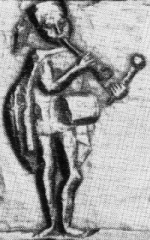 1580's Lancaster Castle 1580's Lancaster Castle
probably part of a casket |
“In 1585, John Taylor published " Drinke and Welcome," in which he mentions
"the fagge-end of an old man's old will, who gave a good somme of mony to a Red-fac'd Ale-drinker who plaid upon a Pipe and Tabor, which was this :
' To make your Pipe and Tabor keepe their sound,
and dye your crimson tincture more profound,
There growes no better medicine on the ground”
[quoted in Rush Bearing] |
| Terminating the performances of Elizabethan plays a morris jig was danced with an infusion of rhyming songs or speeches delivered by the clown
of the theatre to the accompaniment of pipe and tabor. Jigs usually lasted for an hour. The Stationers' registers contain entries in 1595 of two jigs
described respectively as Phillips's "Jig of the Slippers," and
Kempe's "Jig of the Kitchen-stuff Woman." Other jigs referred to by
contemporary writers are "The Jig of the Ship" and "The Jig of Garlick." |
|
1590
“the picked youth, ..., footing the Morris about a May-pole, and he, not hearing the minstrelsie for the fidling, the tune for the sound, nor the pipe for the noise of the tabor, bluntly demaunded if they were not all beside themselves"
Plaine Percevall, the Peace-Maker of England [quoted in Rush Bearing, by Alfred Burton 1891, p107] |
Elizabethan clown actor William Kemp, (also spelled Kempe), morris danced in 1599 between London and Norwich after accepting a bet. He covered the distance of about a hundred miles in nine days. This feat took 4 weeks in total. Thomas Slye was his accompanist and referee.
|
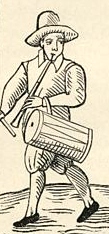 1600,Thomas Sly from 1600,Thomas Sly from
‘Will Kemp’s Nine Days’ Wonder’ |
 |
Wood Sculpture to Will Kempe and Thomas Slye in Chapelfield Gardens, Norwich
Photo: Eric Ortner |
1600 a play called ‘The Shoemaker's Holiday or the Gentle Craft’, Eyre announces that:
“for love to your honour they are come hither with a morris dance”.
(By the tabor, the pipe, and the rhythmic fall of dancing feet, Rose is able to recognize her disguised lover.)
Thomas Dekker (F2v , III.iii.49-50). |
1601 song from 'Jack Drum's Entertainment', talking about the Whitson morris dance:
"Skip it, and frisk it nimbly, nimbly!
Tickle it, tickle it lustily!
Strike up the tabour,
For the wenches' favour,
Tickle it, tickle it lustily!
Let us be seen on Highgate Green,
To dance for the honour of Holloway;
Since we are come hither,
Let's spare for no leather,
To dance for the honour of Holloway."
'Highgate: Part 2 of 2', Old and New London: Volume 5 |
Writers recorded seeing morris men and women dancing to the pipe and tabor:
"In Fleet strete then I heard a shoote :
putt off my hatt, and I made no stave,
And when I came unto the rowte,
Good Lord ! I heard a taber playe,
For so, God save mee ! a Morrys-daunce :
Oh ! ther was sport alone for mee,
in John Brand (1744-1806) |
|
|
|
17th century, in Hereford:
“eighteen persons, the fiddler, the taborer, the four whifiiers, and the twelve dancers in this morris”
page 144
“Old Hall of Hereford. ... the waits of three metropolitan cities make not more music than he can, with his pipe and tabor”
page. 139
“The wood of this old Hall's tabor should have been made a pail to carry water in, ....; but Hall, being wise, because he was, even then, reasonably well stricken in years, saved it from going to the water, and converted it, in those days, to a tabor. So that his tabor hath made bachelors and lasses dance round about the May-pole threescore summers, one after another, in order, and is yet not worm-eaten.”
page 140
In 1609 a tract called " Old Meg of Herefordshire, for a Mayd Marian, and Hereford Toivnc for a Morris Daunce ; or Twclve Morris Dauncers in Hereford- shire of Twclve Hundred Years Old." is dedicated :
" To that renowned Ox-leach, Old Hall, Taborer of Herefordshire, and to his most invincible, weather-beaten, Nutbrowne Tabor, being alreadie old and sound, three-score ycarcs and upward.”
“Alas ! what do I see? Hold, Taborer ! stand, Hobby-horse ! Morris- dancers, lend us your hands ! Behold one of the nimble-legged old gallants is by chance fallen down,”
page 145
Temple says :
" There went about the country a set of morris-dancers, composed of ten men, who danced, a maid marian, and a tabor and pipe."
|
|
|
1770's
Gwilym Davies has researched the history of the pipe and tabor in Gloucestershire up to the present. He found that the pipe and
tabor were played in
Chipping Campden in the 1770's. James Warner (1737-1772) from the town played for morris dancing.
His possible 18th century
pipe has been given to the Gloucestershire Folk Museum which, if it is his, is probably the oldest surviving
instrument known to have
been used for morris dancing. |
|
1772, June 8th
" Warner was an accomplice with Kelly in the murder of Richard Dyer. It seems that KELLY is a famous Morrice-dancer; and on Sunday morning before the fact was committed, he was teaching a set of fellows to dance. WARNER, used to play on the tabor and pipes to the dancers. It is to be hoped the Justices will suppress such nurseries of idleness and drunkenness as Morrice-dancings have generally proved."
Court records GLOUCESTER JOURNAL, 1772 |
|
1733, May 19th in the vicinity of Hempsted, Gloucestershire
" two Children were burnt in a terrible Manner at Hemftead near this City, one of which is fince dead, and the other lies dangeroufly ill: It is obfervable, that the affectionate Father was then attending a Company of Morrice Dancers with his Tabot and Pipe, and when the News of this melancholy Accident was brought to him, he refufed to return home, faying, He would not lofe his Whitfuntide."
Thomas Hill 1706-1739 |
|
|
1807
Died: "On Sunday se'nnight, Mr. James Nicholson, of York; supposed in his day to be the best performer on the pipe and tabor in the kingdom." |
|
|
1811, 19 January
Died "At Easton, near Winchester, aged 94 years,
Mr. John Bucksey, a well-known pipe and tabor player,
who has assisted in promoting the merry dance to at least
three generations of the gay and sprightly."
Jackson's Oxford Journal
1811, 14 January
better known " by the name of Old Bucksey the Fiddler;
his usual instrument, however, was the pipe and tabor.
Few men, in his humble walk of life, were so well known to the fashionable and gay world. "
The Hampshire Telegraph and Sussex Chronicle
|
|
1826, Goswell Road, London; a correspondent, writing to the "Every Day Book," describes what was evidently the same company as being in Rosoman Street, Clerkenwell, in June of the same year :
" They consisted of eight young men, six of whom were dancers, the seventh played the pipe and tabor” |
|
|
1847
“ a very few years before, he witnessed "a numerous retinue of morris-dancers, remarkably well habited, skilfully performing their evolutions to the tune of a tabor and pipe, in the streets of Oxford University ;”
Lytell Geste of Robin Hode, Gutch," 1847, note, p. 365. in Rush Bearing, Alfred Burton, 1891 |
|
1851 WOOTTON, William ('Old Piper') 1768 - 1851
An inquest was held on the 14th inst., at the Locomotive Inn, in this place, by R. Weston, Esq., Coroner, on view of the body of William Wootton, mason, aged 81 years. The deceased was well known in the neighbouring villages, as the "Old Piper." It appears he retired to bed at 7 o'clock in the evening as usual, and about 6 o'clock next morning he spoke to a boy, who left his room about that time, and at half past 8 was found dead in his bed. Verdict - "Visitation of God."
The Banbury Guardian 24 April 1851 |
|
Mid 19th century - John Potter of Sutton, Oxfordshire
One of the best known and respected morris dance musicians in west Oxfordshire during the middle decades of the nineteenth century was John Potter, of Sutton, a village adjacent to Stanton Harcourt. He was renowned over a wide area for playing the instrumental combination of three-holed pipe and tabor drum.
The pipe and taborer Nelson, got so drunk once that he had to be tied upright to a tree so he could continue playing. He performed with several sides in north Oxfordshire. Good musicians were much in demand and sometimes played on a strictly commercial basis for a sum of money agreed before hand. |
|
|
1864
"Finstock Morris danced to tunes played by Stephen Dore and Thomas Langford on the Pipe and Tabor and that they were in
demand with other sides including Ascott-underWychwood in 1864 and even played for Bampton." |
|
|
| By the middle of the nineteenth century fashions were changing and the pipe and tabor dropped out of use. Many old morris dancers when deprived of the whittle and dub's simple tune and steady beat simply gave up. |
|
|
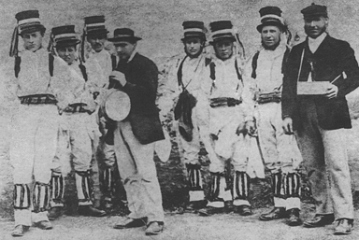 c.1880's Joe Powell (1845-1937) and Bucknell Morris Men c.1880's Joe Powell (1845-1937) and Bucknell Morris Men |
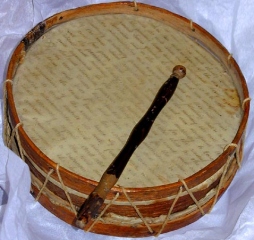 Joe Powell's tabor and stick Joe Powell's tabor and stick
Photog Phil Day
|
This tabor is a fairly standard C19th shallow morris tabor, constructed from a cheese box with second-hand parchment heads.
Pitt Rivers Museum, Oxford. |
|
1882, 13 May
"the minstrelsy of tuneful tabor, pipe, and horn the motley morrice dancers merrily mingling the throng! "
Staffordshire Advertiser |
|
| Early in 1886 Bidford (in Warwickshire) native, seventeen-year-old John Robbins, was sent to Ilmington to learn to play the pipe and tabor, and acquire the morris tune repertoire from James John Arthur (1828–1906). Robbins performed with the Shakespearean Bidford Morris Dancers on the pipe and tabor for morris dancing at least some of the time. |
|
1892
"In every parish they raised a May-pole hung with garlands and ribbons;....
And there was morris-dancing, with Robin Hood, Friar Tuck, Little John,
Tom the Piper, and Tom the Fool, with hobby-horses, pipe and tabor,
mummers and devils, and I know not what;"
London by Walter Besant |
|
1900
..... "These instruments, though they have been played within the memory of living men, are now fallen into disuse. Such traditional Morris-men as still exist amongst us use the fiddle, concertina, or accordion."
The Musical Times |
|
|
 |
1891 Whitson
drawn as though it was the 17th century in Rush Bearing, by Alfred Burton, 1891
|
|
|
|
1903 November 5th
"a November 5th procession in 1903..... London this year;..... procession, which I saw from my window in Kensington about the middle of the day;..... For musicians they had a man playing a shrill long tin whistle or pipe, and another following the cart beating a drum...... . It was a poor vulgar show,..... but it retained in its debased state several of the principal features of the old morris-dance...... the drum and penny whistle represented the ancient tabor and pipe;"
Charlotte Burne remembered |
|
1904
'A SPECIAL Loan Exhibition OF Musical Instruments, Manuscripts, Books, Portraits, And other Mementoes of Music and
Musicians, Formed to commemorate the Tercentenary of the granting by King James I. of a Charter of Incorporation to the
WORSHIPFUL COMPANY OF MUSICIANS in 1604...'
c. 1735 item 924. Pipe and Tabor and two sets of Bells worn on the knees of
the Morris Dancers. —
Belonged to Thomas Humphries, of
Witney Oxon., and was played by him at most of the Morris
Dances
in the villages and towns of Oxfordshire for nearly 40
years. Lent by Mr. W. Taphouse.
c 1750 item 918. Tabor Pipe and Drum. Lent by the Rev. F. W. Galpin.
c 1750 item 785. Morris Dancer's Pipe. Lent by Mr T.W. Taphouse
 [Fred Taphouse (1838-1905) or Thomas William Taphouse]
[Fred Taphouse (1838-1905) or Thomas William Taphouse]
|
|
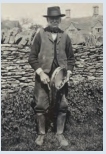 Thomas Pitts 1855 – 1940 Thomas Pitts 1855 – 1940
Gloucerstershire
|
|
1912, 21 February Kidlington "Lamb-Ale"
"A Morris dancer, insert (photog) with the pipe and tabor."
Oxford Journal Illustrated newspaper photographs index, 1909-1928 |
|
.1913,Thaxtead
"...the summer of 1913 as being a high-point for the Thaxted Movement in terms of dance, with much of the town participating,
if not in Morris but in country and social dance. He states that the phenomenon had taken off across all social classes, breaking
down barriers between landowners, clergy and sweetfactory workers.
Noel himself did not take part in the dancing, but his curates did, and the vicar who succeeded him, his son-in-law Jack Putterill,
danced well into his 70s and played pipe and tabor until almost 80. Conrad allowed dancing in church upon occasion,
but Jack began to actively encourage this, and the offertory dance during the church service remains a feature of Morris Ring
events throughout the country."
Revival: The Transformative Potential of English Folksong and Dance, 1880-1940 |
|
|
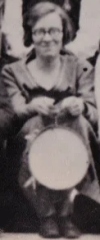 |
1925 J Sherman's photograph taken alongside the Oxford University Morris Men |
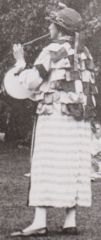 Georgie Taylor, 1925 Georgie Taylor, 1925
playing for morris dancing |
In the 1929/1930's Joan Sharp (1898-1968) played pipe and tabor for morris and country dancing in England and on tour to the USA and Canada. |
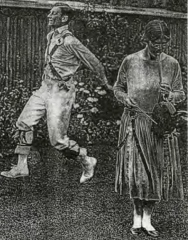 Joan Sharp and Douglas Kennedy Joan Sharp and Douglas Kennedy |
|
| Some morris dancers were completely against women as dancers, managers and musicians until early 21st century. In April 1934, one dancer of the East Surrey Morris wrote a letter in which his criticism of the intervention of women in morris dancing was unequivocal: "As regards men’s morris, my feeling is that it should be entirely man-managed. Women should have nothing to do with its management at all." (source) |
|
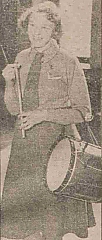 source source |
Despite attitudes such as these some women contributed fully to the morris movement. Winsome Bartlett in 1968 for example helped to set up, teach and play the pipe and tabor for Dartington Morris Men. She also made pipes and tabors, sang and appeared on the radio playing the pipe and tabor (1953). |
|
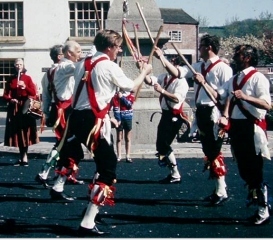 1970 Winsome Bartlett playing for Dartington Morris Men 1970 Winsome Bartlett playing for Dartington Morris Men |
|
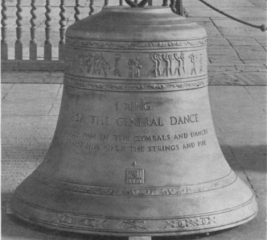 1949 Thaxted, Essex 1949 Thaxted, Essex |
This bell is decorated with a pipe and tabor player and morris dancers. |
|
|
 1950 Berkhampstead 1950 Berkhampstead
|
 1950's Great Dunmow 1950's Great Dunmow |
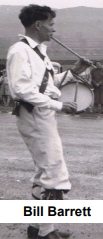 1950's Leeds Morris Men 1950's Leeds Morris Men |
|
1978 Mitcheldean, Gloucestershire
"With a waving of handkerchief s and clashing of sticks , Mitcheldean village's own Morris Men made their first public
appearance
on May 1 this year . ... they danced outside the George Hotel to the music of piano accordian and pipe and tabor" |
|
|
|
|
| |
see other types of dance:
dance of death
18th century dance
moresca |
|
|

 1580's Lancaster Castle
1580's Lancaster Castle




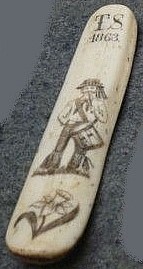




 [Fred Taphouse (1838-1905) or Thomas William Taphouse]
[Fred Taphouse (1838-1905) or Thomas William Taphouse]
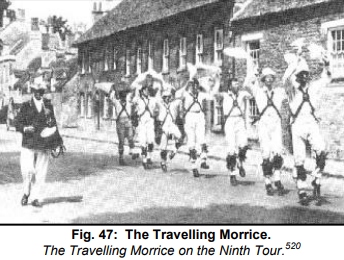





 1949
1949


